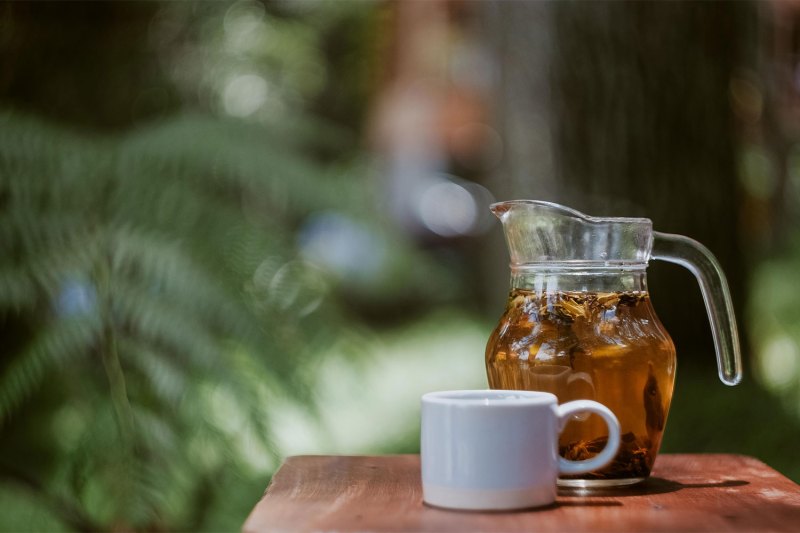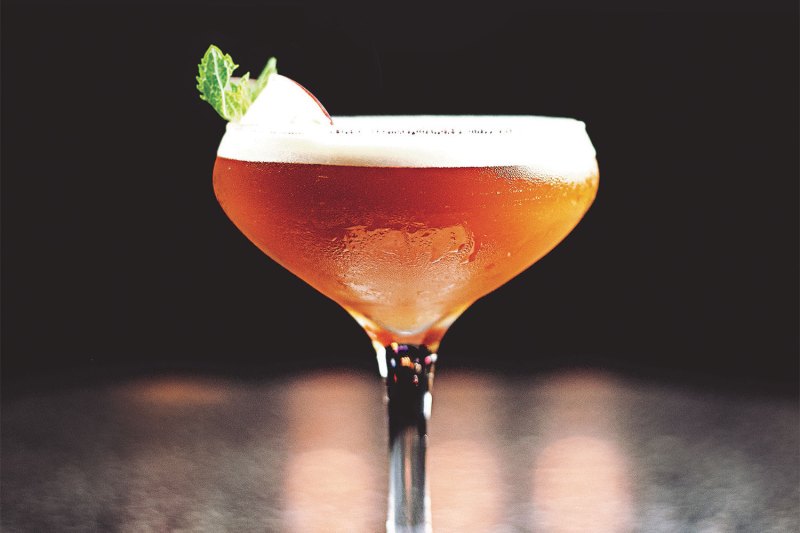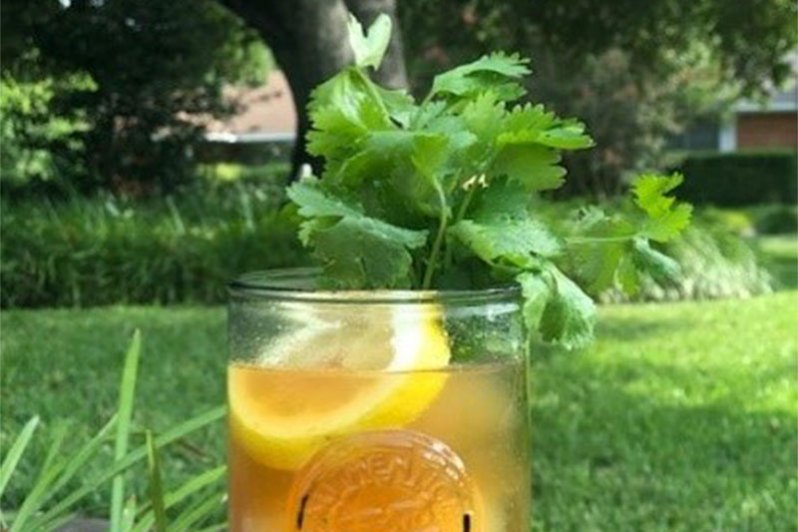As a concept, iced tea spans innumerable cultures and geographical regions, and an iced tea enthusiast in search of variety can easily find hundreds of different prep methods and flavor combinations to keep their options diverse, engaging, and international. When we’re talking about iced tea traditions in the United States, one particular variation often pushes itself to the forefront, largely thanks to the serious devotion it inspires throughout the South: “Sweet tea.”

“In many places in the South, sweet tea is a religious experience,” insists cofounder Austin Sherman of Big Easy Bucha in New Orleans. This form of refreshment, found in Southern refrigerators and on countless restaurant menus, is neatly summed up by its name; the only strictly necessary ingredients for a sweet tea come in the form of iced tea (usually iced black tea) and sugar (either dissolved white sugar or a simple syrup). However, that basic formula is ripe for customization, and inventive sweet tea makers love to experiment with tea-to-sweetener ratios and additions like fruit, fresh herbs, and — of course — spirits. If sipping a sweet tea cocktail on a hot and humid summer afternoon sounds like a brilliant idea (and it does), then these spiked sweet tea tips will help you make the best possible version of this Southern staple.
Herbal teas offer new flavor dimensions to typical sweet tea.
As mentioned above, sweet tea usually consists of black tea that’s sweetened during (or immediately after) the steeping process. But if you’re a fan of flavored or herbal teas and want to attempt a sweet tea rendition using your preferred brew as a base, then co-owner and bar director Elizabeth Turnbull of COPA in Durham, North Carolina urges you to go on ahead. She personally prefers to make her sweet tea with hibiscus tea, telling us that “I was born and raised in Haiti, and my husband was born and raised in Cuba. Throughout the Caribbean, it’s common to enjoy a cold glass of hibiscus tea. The hibiscus flower is prevalent, and it has a light tartness that makes it extra refreshing.” When making a spiked sweet hibiscus tea, Turnbull sticks to her island inspiration by mixing the tea with simple syrup and pineapple rum.
Instead of boiling water to make the tea, try steeping it in direct sunlight.
In most cases, tea requires boiling water to draw the flavor out of the tea bags or loose leaves. However, mixologist John Wadell of Peerless Bourbon in Louisville, Kentucky points out that “the trick to a good Southern sweet tea is to leave [the tea and water] out in the sun rather than to boil the water. [This is] also known as ‘sun tea.’ Start out by adding your tea bags to a pitcher of water, [then] let it sit out [in the sun] for at least 4-5 hours, depending on how hot it is outside and how many bags you plan on adding for your flavor preference, I find it better to use a lot [of tea bags].”
In addition to sugar, sweet tea often includes fruit as a sweetener.
Southern growing conditions yield impressive seasonal fruit harvests, and sweet tea serves as an ideal canvas for these flavors and natural sources of sweetness. When selecting fresh-grown fruits and herbs to include in his sweet tea, bartender Brandon Davidson of Pressroom in Bentonville, Arkansas chooses “stone fruits during the summer: peaches, apricots, nectarines. For herbs, mint is always a nice addition to your iced tea, spiked or not. We use a fruit liqueur in our tea, but you can also muddle fresh fruit to add to your drink or garnish with a fresh slice of peach or apricot.”
Bartender Adrienne Miller of Satterfield’s in Birmingham, Alabama also loves fruit in her sweet tea, but her particular selections differ somewhat: “Blackberries are best! They always take the spiked tea to another level and provide an element of tartness and flavor. Oh, and when they are in season, kumquats are great with spiked sweet tea. Both of these are great because their sweet-tart flavor pairs so well with the earthy and nutty notes any type of tea carries.”
Tea syrups simplify the process and offer a cocktail-focused spin on a classic sweet tea.
Pro bartenders tend to be big fans of infused syrups, crediting these products with simplifying the cocktail-making process and delivering both flavor and sweetness in one fell swoop. Rather than making his spiked sweet tea with a base of brewed tea, bartender Vinnie Dugan of Seven Lamps in Atlanta chooses to combine the tea and the sweetener, making a simple syrup infused with both black tea and thyme. He then uses gin (Bulrush Gin is his preference) as the spirit in his spiked sweet tea and shakes the cocktail with mint leaves, explaining that “when it’s 95 degrees outside and 90% humidity, gin is the first bottle I reach for. Bulrush has wonderful notes of citrus that really lift up the flavors of the tea and thyme in the cocktail, and the mint gives it a kick of freshness to finish off. I really love the way fresh herbs lift up this cocktail to create something so refreshing that you just can’t wait to have another one.”
When it comes to sweet tea spirits, you have a LOT of options.
Sweet tea makers who hew very closely to tradition tend to opt for that most Southern of all spirits: bourbon whiskey. But nowadays, Southern mixologists see no reason to adhere to any strict rules on this front, and several our sources seek out opportunities to try different liquor-sweet tea combinations, resulting in flavorful and imaginative cocktails.
- Bourbon: “I always use bourbon for my spiked sweet tea; not only is it perfect thematically, but the flavors are a perfect match. Tea, even when sweetened, takes its dominant flavor from bitter tannins. Bourbon gets much of its flavor from the tannins in the wood barrels used to age it. So the flavors blend together pretty well,” says beverage director Bryson Downham of Toups Meatery in New Orleans. “Maker’s Mark is a great choice; the softness from the wheat really makes space for the tea.”
Lead bartender Ellen Talbot of Fable Lounge in Nashville also chooses classic bourbon for her sweet tea, specifically claiming that “Buffalo Trace bourbon is smooth, slightly sweet and would go great in a spiked sweet tea.” Her magic ratio of tea to spirits to sweeteners? “I’d say four parts tea : one part sugar (or simple syrup) : one part spirit for balance.”
Just as tea-infused syrup can give sweet tea a fancy-cocktail makeover, tea-infused spirits can accomplish the same task. At Foode in Fredericksburg, Virginia, owner/executive chef Joy Crump and her bar team use black tea-infused bourbon to create its “Grown Folk’s Tea,” which the company describes as “a cocktail that, on its surface, is fun and drinkable in its familiarity, like a simple sweet iced tea in the summertime. But it has layers and complexity from the black tea slow-steeped in bourbon; notes that make it more than just a drink — it’s a time-tested pleasure that’s earned.” In order to achieve its signature tea-bourbon hybrid, Crump & Co. “steeps the tea bags in the bourbon (they prefer Bowman’s Bourbon) under refrigeration. Remove the tea bags gently without squeezing. This will keep the final product exactly like you’d want your sweet tea: crisp, bright and cloud-free.”
- Vodka: Vodka’s crisp neutrality is sometimes discussed as a strike against it, but bartender and general manager Rochelle Tougas of FM Kitchen & Bar in Houston, Texas views this quality as a positive in the context of sweet tea. When asked for her particular sweet tea vodka of choice, Tougas told us that she uses “Monopolowa, as it’s just a clean vodka, [it’s] not crazy expensive, [and it goes down] without the burn.”
- Moonshine: White whiskey, which doesn’t experience barrel aging, drinks more like a vodka than like a bourbon, making it an intriguing middle ground between the other two spirits on our list. Bartender Kathy Barnette, who hails from Tennessee and now works behind the stick at the Holiday Inn Express Orange Beach in Florida, likes to use blackberry-flavored moonshine in her sweet tea, also adding a blackberry reduction to highlight the fruit essence and to offset the tea’s sweetness with a welcome tang.
The Palmetto Sweet Tea Cocktail
(By Peter Nickle, mixologist, The Icehouse Restaurant, Summerville, South Carolina)

The town of Summerville claims distinction as the “birthplace of sweet tea,” so it stands to reason that a skilled bartender working in this area would have an excellent spiked sweet tea in his repertoire. Peter Nickle’s version includes sweet tea, apple cider, mint, and bourbon, resulting in a beverage that “delivers enough punch to not be overshadowed by the tea and cider. This cocktail is kind of a twist on another Southern classic, the mint julep, where the tea and cider act as the sweeteners.”
Ingredients:
- 1.5 oz bourbon (Nickle uses Revival High Wire Bourbon)
- 1.5 oz of sweet tea (using a ratio of 1 gallon tea to 1 cup sugar)
- 1 oz apple cider
- 4-5 mint leaves
Method:
- Add all ingredients to a cocktail shaker and muddle the mint leaves.
- Add ice to the shaker and shake until fully mixed and chilled.
- Strain and serve in a chilled coupe glass or in a rocks glass with a single ice cube. Garnish with apple slice and mint.
Texas Sun
(By Danny Caffall, lead bartender, The Mansion Bar, Dallas)

Whether or not the great state of Texas can be considered part of “the South” remains a hotly debated topic. But when it comes to sweet tea, Lone Star residents have a completely Southern appreciation for this drink, and bartender Danny Caffall counts himself among that number. Caffall describes his Texas Sun cocktail as “a Texas spin on spiked sweet tea, using tequila as the chosen liquor and incorporating a homemade peach compote.”
Ingredients:
- 1.5 oz reposado tequila
- .5 oz ancho chile liqueur (Caffall uses Ancho Reyes)
- .5-.75 oz organic blue agave nectar
- 1 oz. peach compote*
- .5 oz fresh lemon juice
- 4 oz unsweetened iced tea (or “sun tea”)
Method:
- Add tequila, ancho chile liqueur, agave nectar, peach compote, and lemon juice to a shaker tin over ice.
- Shake vigorously and strain over ice into a Collins glass.
- Top with iced tea and garnish with cilantro and lemon wheel.
*Peach Compote:
- Add 3-6 peaches (pitted and roughly chopped), 3 tbsps light brown sugar, 1 star anise, 1 tbsp vanilla bean or extract, 2 tbsps water, and a pinch of salt to a saucepan over medium heat. Bring the mixture to a gentle boil, stirring frequently. Cook for 10 minutes.
- Remove from heat and remove star anise.
- Use a blender or an immersion blender to liquify the compote. Allow to fully cool.



